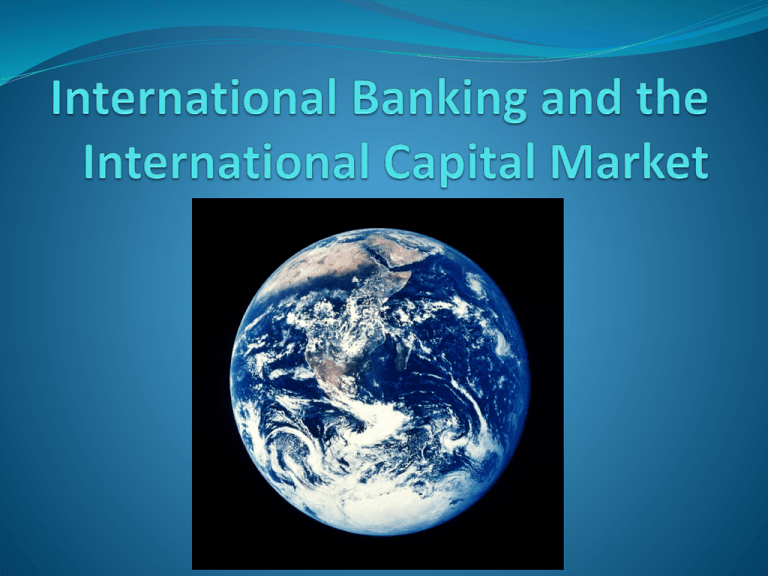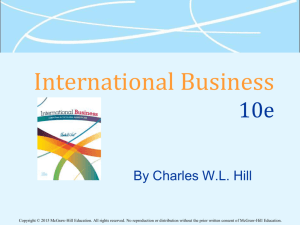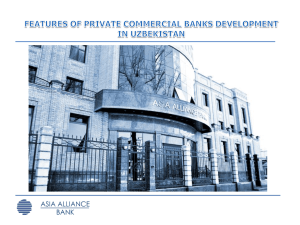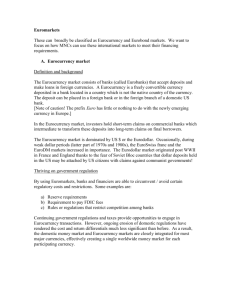14-1
advertisement

Outline Introduction to the international capital market The players of the ICM Growth of the ICM Offshore banking and offshore currency trading Growth of Eurocurrency trading Importance of regulatory asymmetries Introduction to the ICM Introduction to the ICM Definition: the market in which residents of different countries trade assets It is not a single market There is no physical location Most activity is in a network of world financial centers The ICM exists because of international trade The ICM also adds to the gains of trade by lowering transaction costs The Players of the ICM The Players of the ICM Commercial banks Bulk of the ICM Run the international payments mechanism Broad range of financial activities Free to pursue goals overseas that they can’t do domestically Multinational Corporations Finance investments through foreign sources of funds Use equity securities as well as debt securities Denominate their bonds in the foreign currency The Players of the ICM Nonbank Financial Institutions Insurance companies, pension funds, mutual funds, hedge funds Investment Banks Not banks; specialize in underwriting sales of stocks and bonds by corporations and governments Glass-Steagall Act of 1932: commercial and investment banks were required to remain separate within the U.S. until 1999 However, banks do not have such restrictions overseas Central Banks and Other Government Agencies Central banks are routinely involved in the ICM Government agencies routinely borrow from abroad Developing countries and state-owned enterprises borrow from foreign commercial banks Growth of the ICM Growth of the ICM The ICM has grown faster than world GDP since 1970 Fewer barriers to private capital flows across borders, especially in OECD countries Advances in communication technologies The demise of fixed exchange rates Growth of the ICM The Impossible Trinity • A country can pick one side but must give up far corner Free capital flows • Under the Bretton-Woods system, every country had to choose between Option 1 Option 2 options 2 or 3 (U.S.) (Greece) • Without the Bretton-Woods system, countries could now pick option 1 Independent Fixed • This allowed for more free movement monetary exchange Option 3 of capital and led to the growth of the policy rate (P.R. of China) ICM Offshore Banking and Offshore Currency Trading Offshore Banking and Offshore Currency Trading Offshore banking – business that banks’ foreign offices conduct outside of their home countries Banks conduct foreign business through 3 institutions Agency offices abroad arranges loans, transfers funds does not accept deposits Subsidiary banks abroad A foreign bank is the controlling owner Subject to regulations in foreign country, but not subject to regulations in the parent bank’s country Foreign branches An office of the home bank in another country Carry out same business as local banks Subject to home and foreign banking regulations Branches often can take advantage of cross-border regulatory differences Offshore Banking and Offshore Currency Trading Offshore currency deposit – a bank deposit in a currency other than that bank’s home country currency For example, dollar deposits in a bank in Frankfurt Offshore currency deposits are often referred to as “Eurocurrencies” The term “Eurocurrency” does not mean the “euro” currency Eurocurrency trading happens all over the world – not just in Europe Banks that accept Eurocurrency deposits are called Eurobanks – even if they’re not in Europe Offshore Banking and Offshore Currency Trading Rapid growth of offshore banking and currency trading has been caused, in part, by an increase in international trade and the multinational nature of corporate activity Firms involved in international trade require overseas financial services Another reason for rapid growth is banks’ desire “to escape” domestic regulations and taxes Banks shift some operations abroad and into foreign currencies Depositors hold currency outside the issuing country also for political reasons Growth of Eurocurrency Trading Growth of Eurocurrency Trading Remember . . . “Eurocurrency” DOES NOT MEAN the “euro” currency! Eurodollars were born in the late 1950s to respond to the needs caused by growing international trade London started and is the leader in Eurocurrency trading European firms involved in trade needed to hold dollar deposits or borrow dollars Those firms found it cheaper and more convenient to deal with local banks familiar with their circumstances rather than do business with banks in the U.S. Growth of Eurocurrency Trading Early Eurodollar trading grew due to regulations and political concerns Federal Reserve Regulation Q – imposed a ceiling on interest rates U.S. banks could pay on time deposits Cold War spurred growth of Eurodollar market The move to floating exchange rates slowed growth of Eurocurrency markets Importance of Regulatory Asymmetries Importance of Regulatory Asymmetries Major factor behind the continuing profitability of Eurocurrency trading Domestic currency deposits are heavily regulated to control money supply Banks are given far more freedom in dealing with foreign currencies Example: reserve requirements Financial centers with the fewest government restrictions on foreign currencies are the main Eurocurrency trading centers











